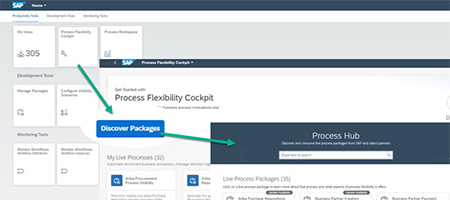Accelerate Automation In SAP Workflow Management
By Milton Rodrigues, Product Manager and Solution Expert for SAP Workflow Management, SAP, Archana Shukla, Senior Product Manager, SAP, Stephan Schluchter, Product Manager for SAP Workflow Management, SAP
It may be a bold statement to say that business processes “run the world,” but there’s truth to it. As evidence, look inside your organization. How many encounters do you have with processes, and the applications that support them 24/7, daily? The answer is every time you interact with suppliers, customers, and other organizations.
Standard business processes are essential for keeping the wheels of your organization turning – connecting different stakeholders and running dedicated business applications, like SAP S/4HANA or SAP ERP. These vital processes help organizations ensure the right goods are produced, customers receive their orders, invoices are paid, leave requests are approved, employees receive proper salaries, and more
In addition to standard business processes, organizations must consider how workflows run across organizations, people, and business applications – either embedded as standard workflows in applications or as extensions and across different lines of business.
These workflows, created to differentiate or function as extensions to standard business processes, can be tricky to work with, especially when it comes to automation.
Is your workflow working seamlessly and as efficiently as possible? Is it traceable and running without too many errors? If not, how can you overcome these issues?
In this article, we highlight how SAP Workflow Management, including live process content packages, can help simplify and accelerate the journey. You will read about non-standard workflows, the role of process automation to reduce business complexity in the last mile of automation, and how to access live process content packages.
Addressing Business-Critical Needs with Live Process Content Packages
SAP Workflow Management provides capabilities to digitize workflows, automate and extend business processes, manage decision logic, gain end-to-end process visibility, and configure process variants in a no-code environment. It allows organizations to create workflows and extensions, include business rules, add essential approval levels, run conditional logic for specific workflow variants, and more.

A key benefit of SAP Workflow Management is that it enables enterprises to address business-critical changes flexibly, without the need to know any technical language or IT tools – low-code/no-code (LCNC) in action. This process flexibility capability provides opportunities for:
- Developers and business users to flexibly adapt changes to workflows and decisions in an LCNC environment.
- Organizations to enrich existing business processes with intelligence by introducing visibility to end-to-end business processes, spanning multiple systems.
- Business experts to leverage the capabilities of SAP Integration Suite to connect SAP line-of business applications — with each other and with SAP Workflow Management for business process orchestrations.
Not every organization wants to build non-standard workflows from scratch every time. The release of SAP Workflow Management introduces common, adaptable patterns to help organizations accelerate the automation journey. These patterns, which contain pre-built process templates, workflows, user interfaces, decision logic, and visibility scenarios, are based on very common use cases from SAP customers and partners.
Agility and Flexibility to Create Business Processes
SAP solutions like SAP Ariba, SAP S/4HANA, and SAP SuccessFactors provide standard processes for customers. But most organizations require customization and extensions beyond what these standard processes offer out of the box.
What’s more, the agility and flexibility to build or enhance business process capabilities on the f ly are increasingly becoming a business imperative for customers. Customers also benefit and succeed overall by digitizing workflows and transforming existing (or net new) processes into intelligent workflows. SAP has worked with process and solution experts to address the challenges and discover scopes of enhancements and extensions in the standard processes, providing accelerators that add flexibility, extensions, and intelligence into the existing business processes.
With the release of SAP Workflow Management, we introduced these accelerators as live process content packages for different use cases. The live process content packages, which also contain applications such as UI5 Tooling and UI5 Automation Designer, the SAP
Cloud Application Programming Model, and integration flows for SAP Integration Suite to support relevant content, are published in the SAP API Business Hub.
Live process content packages address different needs, here are a few examples:
- Capital expenditure approval
- Purchase requisition approval in SAP ERP
- Manage invoices without purchase order in SAP ERP
- Manage purchase info record in SAP ERP
- Visibility into SAP Ariba procurement operations
- Document-centric approval process
- Manage sales order approvals in SAP S/4HANA
- Manage credit block on sales orders in SAP S/4HANA
To expand on what these live process content packages represent, let’s take a look at an example using the sales and distribution capabilities in SAP S/4HANA.
In a typical lead-to-cash process flow, the process can be configured for internal approval (via flexible workflows) or external approvals after the user creates a standard order. When the user processes a sales order, the system can automatically carry out essential
functions, such as pricing, availability check, credit limit check, etc. A credit limit check failure is an exception in the process, and the order is blocked for further processing until the block is removed. Additional packages cater to automation of approvals of sales orders, credit memo request, sales quotations, and more.

Live process content packages provide reusable process steps or workflows to validate, per form approvals on the respective standard orders, and subsequently release or reject them in SAP S/4HANA.
Additional validations can be performed using business rules, providing flexibility to determine the processors for the approval tasks. Process variants can be created and dynamically triggered with the help of start conditions. Similarly, steps within each variant can also be executed or skipped based on step conditions, bringing in granular flexibility.
Process visibility offers out-of-the-box insights into key process performance indicators like open sales orders, approval cycle time, the number of credit blocked sales orders, etc. It is packaged with integration content and an event mesh that enables event-driven architecture that automatically creates a workflow in SAP Workflow Management based on the start conditions.
Developers, business process experts, and even citizen developers can create process variants, edit business rules, and enhance the visibility scenarios – resulting in changes to the process and the process dashboard – on the fly and without any coding. Live
process content packages are all plug-and-play with SAP S/4HANA, so there are no additional standard orders development requirements.
The packages address flexible automation, insights to end-to-end heterogeneous processes, document-centric workflow capabilities, and easy-to-implement business decisions in various business processes that can benefit from these capabilities.
How to Access and Use Live Process Content Packages
Live process content packages contain references to digital workflows, decisions, process visibility scenarios, user interfaces, and cloud application programming model modules. Developers – typically business process experts or citizen developers – can discover, import, configure, and set up content packages in the Process Flexibility Cockpit through the Process Hub.
Here is where a user can leverage LCNC configuration tools to:
- Flexibly extend and adapt workflows running in their
packaged applications. - Manage process variants and decision logic.
- Model process performance indicators to track
business-critical KPIs in real time. - Get end-to-end insights on the processes.
Based on the business need and use case, some content packages have an accompanying SAP UI5 application template that can be used with minimal configurations or as a reference to build your own application.
Examples include Managing Invoices without Purchase Orders and Managing Approvals for Capital Expenditures. Other packages have configurations to easily plug and play the content with SAP S/4HANA or SAP ERP Central Component, using the SAP Event Mesh and accompanying integration content where relevant.
Each package comes with descriptive material to guide the user to set up and use the content. How can a user identify and configure the live process content package? Let’s use an example of a business process expert with the urgent need to address external approvals for credit memo requests in their SAP S/4HANA Cloud system. In this scenario, a business process expert may take the following steps:
Step 1: Access the Process Hub via the Process Flexibility Cockpit. Here, a business process expert can view all the available and relevant content packages.

Step 2: Search for the right package. The business process expert looking to manage external approvals on credit memo requests in SAP S/4HANA can do a simple search for “manage credit memo request” (or relevant information) in the Process Hub. The search will produce a list of all available relevant packages.

Step 3: Choose and import the package. The search results will display a box titled “Manage Credit Memo Request.” After selecting it, the business process expert can import the package. Note that if the package is already imported, you have the option to configure them or update them when an update is available.

Step 4: Process Flexibility Cockpit. The selected package is brought into the business process expert’s Process Flexibility Cockpit. The user can perform subsequent actions (creating process variants, modifying decisions, modifying visibility scenarios, and getting insights into end-to-end business processes) right from the cockpit.

Step 5: Creating a process variant. With the content package in the cockpit, the user can create and/or maintain existing process variants to cater to changing business requirements. Using the Manage Process Variant application to create a process variant, simply drag and drop the required process steps from the available steps, configure the steps, and activate the variant.

Step 6: Start conditions provide instruction on which process variants are triggered and the steps that should be executed based on conditions. Figure 7 shows an example of a variant where a two-step approval will be triggered if the total net amount exceeds 5,000, and the transaction currency is in U.S. dollars. Start Conditions and Step Conditions. Step-level conditions allow more granular flexibility on the process variant. Based on the business object’s data, these step level conditions determine whether a step should be triggered or skipped. As displayed in the High New Value Credit Memo Requests example in Figure 8, an additional approval step can be explicitly triggered if the request is credit blocked.

Step 7: Manage business decisions. With the Manage Decisions application (see Figure 9), a business process expert can view, modify, and activate business decisions. By definition, a decision consists of one or more policies, and each policy consists of a collection of rules.

Step 8: Assign possible processors. A common requirement for any approval process is assigning suitable processors for the task. With a business decision such as Determine Approver (see Figure 10), the business process expert can define and assign the right user group/person to the task based on values from the business object.

Step 9: Manage insights. The Process Flexibility Cockpit provides an overview of your business scenario with insights on the process: all credit memo requests in a configured SAP S/4HANA system are in the example below. Process Visibility gives realtime visibility on the requests in your configured SAP S/4HANA system in this case. While the package comes with out-of-the-box visibility, with Configure Visibility Scenarios (see Figure 11), a user can enhance the scenario with desired metrics and process performance indicators.

Activate the changes. Once the changes are activated, they will reflect in the Visibility Scenario of the process. Live process insights can be viewed directly within the Process Flexibility Cockpit and provisioned to the right people in the SAP Fiori launchpad. Navigating into it will display the process workspace for the scenario.

Live Process Content Package In Action
Once you’ve done all the above, your content package is ready to be used in a productive environment. In the following (see Figure 13), when a new credit memo request is created in your configured SAP S/4HANA systems, if it is marked for external approval and the
order reason matches the configured reason for approval request, then the relevant process variant is triggered based on the start conditions.
The approval task is assigned to the task owner – the package’s business rules decide this. The task owner will receive the task in the My Inbox application with all the details to approve or reject the request (see Figure 13).

When the request is approved, it is released for further processing in the SAP S/4HANA system. The approval status will show “Released” as the status of the Credit Memo Request (see Figure 14). Similarly, when rejected, the approval status is updated as “Rejected” (see Figure 15).


Using live process content packages will fundamentally accelerate your automation efforts. You can now start enhancing the process to include bot automation as digital workers or digital assistance. One option would be to leverage SAP Conversational AI to create a chatbot that will help the business user run the process, drive the right decisions, and get the needed context details at the right time.
Combining SAP Workflow Management with bots created or also pre-built with SAP Intelligent Robotic Process Automation can eliminate mundane, repetitive tasks in a business process or use automation to extract data from different data sources, like emails, spreadsheets, and documents as images, for example, to trigger the start of a workflow. The following resources provide use cases and opportunities worth consideration and guidance on how to get started with accessing and using live process content packages:
- The tutorial, Discover and Configure Live Process Content with Workflow Management, provides an overview of how to import and set up a sample workflow content package into your landscape.
- The blog, Compendium of SAP Workflow Management Missions, sheds some light on some of the published packages and provides guidance on setting up, configuring, and consuming them.
- Explore all available live process content packages for SAP Workflow Management in SAP API Business Hub.
A Partner Ecosystem For Industry-Specific Demands
The SAP Partner ecosystem is vital in expanding and scaling the automation and adoption of end-to-end business processes across different industries. These partners have the needed expertise, skills, and domain knowledge to deliver unique complementary solutions to meet market demands. Customers are looking for updated versions of the SAP solutions without profoundly disrupting their existing investment. Partners can integrate with new technologies and services to re-invent existing processes, helping customers increase value, create unique experiences, and open new avenues of business transformation.
The SAP and IBM Evolution partnership is one such initiative to deliver unique end-to-end cloud-based solutions and derive effective business transformation across different industry verticals. The first set of solutions from IBM targets the industrial machinery and components (IM&C) industry, focusing on lead-to-order and plan-to-manufacture processes. IBM has released four live process content packages in SAP API Business Hub based on the IM&C industry. These content packages are designed and built using SAP Workflow Management. They orchestrate and automate Figure 16 The content package developed by IBM – access the description via SAP API
Business Hub workflow and processes across disparate systems like SAP S/4HANA, SAP Field Service Management, SAP Internet of Things, SAP Sales Cloud, the SAP Customer Experience portfolio, and more. These solutions offer increased productivity and customer satisfaction to address industry-specific demands (see Figure 16).

The new redesigned content, based on SAP Business Technology Platform services and industry-cloud solutions, enables clients to modernize automation of processes and decision making. The content helps provide advanced insights to identify bottlenecks, seamlessly integrate across systems, and extend the existing capabilities in SAP applications with the latest technologies.
Combining the partner ecosystem and SAP’s offerings in process automation is the start of a new journey to deliver industry-ready pre-delivered workflow content packages that help customers become fully automated and intelligent enterprises.
Which scenarios would you like to see SAP or SAP Partners implement as pre-built content? Share your feedback or join the conversation in the SAP Community around SAP Workflow Management.








